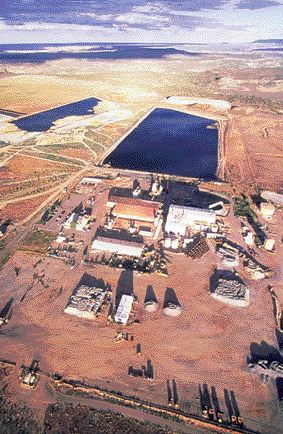Vancouver — With the uranium spot price reaching an all-time high of US$45 per lb., International Uranium (Iuc-T, IUCPF-O) is reviving some of its mines located in the Four Corners area of southwestern U.S., near the junction of the Arizona, Colorado, New Mexico and Utah state borders.
Mining operations have been restarted on Colorado Plateau-area projects and are planned at the Henry Mountains and Arizona Strip districts, with ore to be trucked and stockpiled at International Uranium’s (IUC’s) White Mesa uranium-vanadium mill in southeastern Utah.
The company anticipates an initial production rate of about 3.4 million lbs. U3O8 and 5.9 million lbs. vanadium in 2008 while the stockpiles are processed, then settling in at about 1.5 to 2 million lbs. U3O8 annually thereafter.
The White Mesa mill has been in operation for over 20 years and is strategically situated close to most of the major western U.S. uranium deposits.
“The mill has a relatively large capacity,” says International Uranium president and CEO Ron Hochstein. “It’s one of the few mills that is dual-circuit. Currently, there are four mills left in the U.S., and only two of them have the dual uranium-vanadium circuit.”
The other is the Cotter mill in Caon City, Colo.
Hochstein says White Mesa is currently processing alternate feed material from Cameco (CCO-T, CCJ-N) and is expected to produce about 500,000 lbs. U3O8 this year.
“This is a key asset for us in that it’s enabled us to bring our mines into production,” Hochstein says. “It is the only mill really available at this time for a number of mines. Our (processing) capacity that will be used for our mines is only about fifty to sixty-five per cent, so we’ll have room for both toll-milling, purchased ore and obviously our own ore sources.”
Taking on toll milling and purchased ore agreements could expedite the startup of the mill, which could pull in ore from mines within a radius of up to 563 km.
Capacity at White Mesa is actually defined in a few ways: licensed capacity is 8 million lbs. per year based on its radioactive materials licence with the state of Utah; the maximum throughput rate is 2,000 tons per day; and the plant’s licensed tailing capacity is 10 million tons, of which only 4 million tons has been used. The company is also in the process of getting state approval to reline cell 4A (initially built by Union Carbide subsidiary Umetco Minerals in the late 1980s), which will add about 2.2 million tons of tailings capacity.
Colorado Plateau
IUC is immediately reviving operations at its Pandora, Topaz, Sunday and St. Jude mines, located in the Colorado Plateau area, to be followed by two additional mines early next year. All of the company’s mines in the district, which straddles the southern border between Colorado and Utah, are fully permitted. Mineralization is associated with the Uravan mineral belt where uranium has been deposited into alluvial fan formations (sandstones) by ancient braided stream systems to form elongated, tabular bodies, paralleling bedding within the paleochannels. The deposits contain a combined historical resource estimate of 1.34 million tons grading 0.208% U3O8 and 1.23% V2O5, or about 5.5 million contained pounds U3O8 and almost 33 million lbs. V2O5.
“We are going with contract mining,” Hochstein says. “We’ve been into these mines now, we started opening them up about a year ago, so we know the conditions underground — and in fact, in Pandora, it’s drilled off and ready to go on the first ore face.”
At IUC’s Henry Mountains complex, in southeastern Utah, permitting of the Tony M mine is planned with operations expected to begin by mid-2007. Development of the Bullfrog deposit will start in mid-2007 with production by the middle of the following year. The deposits host a 5.4-million-ton historical resource averaging 0.22% U3O8 for about 24 million contained pounds U3O8. Uranium deposits are hosted in basal sandstones related to the mineralization in the Colorado Plateau district to the east.
Arizona Strip contains a 298,000-ton historical resource in four deposits that average 0.66% U3O8, giving about 4 million contained pounds U3O8. Uranium mineralization in the northeastern Arizona camp occurs in a solution breccia environment with the mineral (primarily pitchblende) concentrated within the matrix material (sand, silt and clay).
Overall, the company’s U.S. uranium deposits and mill stockpiles host a contained resource of about 33.4 million lbs. U3O8 and 32.3 million lbs. vanadium.
Vanadium is principally an alloying agent for steel, used in specialty stainless steels and for its resistance to corrosion and heat. Prices for the metal are currently in the US$8-US$10 per lb. range.
With all primary U.S. uranium production currently coming from mines in Texas and Wyoming, IUC’s move will reopen other previously producing areas.
The company has not entered into any uranium sale contracts yet, but could consider the option to benefit from current buoyant metals prices.
IUC entered the uranium industry in 1997 through its acquisition of the uranium-producing assets of Energy Fuels for US$20.5 million. Besides its U.S. projects, Energy Fuels’ portfolio included uranium projects in Mongolia. IUC also holds Canadian projects in northern Saskatchewan’s Athabasca basin and in Labrador.
With 88.4 million shares outstanding, the company posts a $486-million market capitalization given its recent $5.50 trading level. The stock has traded in a 52-week range of $4.28-$8.15.


Be the first to comment on "Int’l Uranium fires up US mines"